Crude Oil Back to Fundementals as Pentagon Vetoes US Strike against Iran
Commodities / Crude Oil Dec 12, 2007 - 12:05 AM GMTBy: Gary_Dorsch

 Nearly two years ago, on January 10th, 2006, Iranian leader Mahmoud Ahmadinejad raised the stakes in a battle of wits between Tehran and the Bush administration, ordering the removal of UN seals on centrifuges to enrich uranium, a process which can make atomic reactor fuel or weapons-grade material. “We are not going to yield to pressure to abandon our rights, and we have the necessary tools to protect ourselves,” Ahmadinejad told the Qatari foreign minister.
Nearly two years ago, on January 10th, 2006, Iranian leader Mahmoud Ahmadinejad raised the stakes in a battle of wits between Tehran and the Bush administration, ordering the removal of UN seals on centrifuges to enrich uranium, a process which can make atomic reactor fuel or weapons-grade material. “We are not going to yield to pressure to abandon our rights, and we have the necessary tools to protect ourselves,” Ahmadinejad told the Qatari foreign minister.
Ahmadinejad's daring move quickly set off a “war of words” with US President George Bush and vice-president Dick Cheney, which in turn, built-up an Iranian “war premium” of roughly $12 per barrel into the price of crude oil. On January 19, 2006, Cheney warned, “Whether or not there would be a spike in the price of oil, if in fact there is some kind of a crisis with Iran is entirely possible. But I think the consequences of that would be less significant than the consequences of having Mahmoud Ahmadinejad armed with nuclear weapons,” Cheney told CNBC.
Then five days later, on Jan 24, 2006, in remarks at Kansas State University, Bush added, “The world cannot be put in a position where we can be blackmailed by a nuclear weapon.” Iran's Supreme Leader Ayatollah Ali Khamenei responded in a televised speech. “We emphasize that nuclear technology and the nuclear fuel cycle is our absolute right. The nation, I and other officials will not yield to America's bullying language by any means,” Khamenei declared on March 21, 2006.
The unrelenting “war of words” between Tehran and the Washington neocons reached a climax on Oct 17, 2007, when Bush suggested that if Iran obtained nuclear weapons, it could lead to war. “I've told people that if you're interested in avoiding World War III, it seems like you ought to be interested in preventing Iran from having the knowledge necessary to make a nuclear weapon,” he warned.
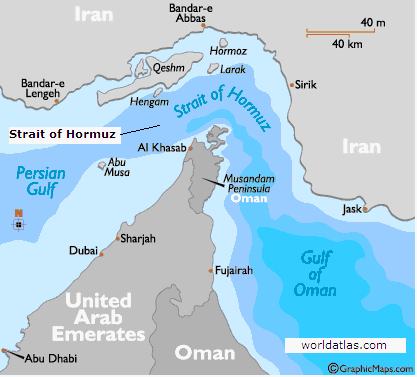
Then four days later, on Oct 21st, VP Cheney warned, “Our country, and the entire international community, cannot stand by as a terror-supporting state fulfills its grandest ambitions. If Iran continues on its current course, the US and other nations are prepared to impose serious consequences. We will not allow Iran to have a nuclear weapon,” Cheney declared.
Still, Iran's leadership refused to yield to the psychological pressure from the Bush clan, girded with the staunch support of China and Russia at the United Nations, and Venezuela's Hugo Chavez, who threatened to cutoff oil exports of 1.5 million barrels per day to the US, if Bush decided to bomb Iran's nuclear facilities. Chavez warned that crude oil would hit $200 per barrel, if Bush gave orders to attack Iran.
Tehran knows it holds the ultimate “trump card”, in its high stakes confrontation with the Bush clan. In March 2005, Iranian Expediency Council secretary Mohsen Rezai first raised the prospect of Iranian retaliation against all Middle Eastern oil exports. “An attack on Iran will be tantamount to endangering Saudi Arabia, Kuwait and in a word, the entire Middle East oil. Iran could easily block the Straits of Hormuz and use its missiles to strike tankers and GCC oil facilities,” he warned.
About 40% of the world's crude oil exports pass through the two-mile wide channel of the strategic Straits of Hormuz, with Iranian military forces deployed at the head of the channel. Seeking to avoid a spike in crude oil to $200 per barrel, the Bush clan pursued a dual track policy of “psychological warfare” with Iran through the media, while trying to enlist other nations to enact economic sanctions against Iran, in a desperate effort to stop Iran's quest for nuclear invincibility.
Pentagon Vetoes US Strike against Iran, Alters Mid-East Order
However, Bush's dual track policy of economic sanctions and verbal jousting with Tehran suddenly burst into flames last week. The Pentagon's top brass, led by chairman of the US Joint Chiefs of Staff Admiral Michael Mullen, US defense chief Robert Gates and Admiral William Fallon, commander of the US Central Command, rubber stamped a US spy report, that squashed mounting speculation of a US aerial attack on Iran during Mr Bush's final year in the White House.
The US military contributes nine of the 16 intelligence agencies whose views are cobbled together into the NIE. As of now, US intelligence has “high confidence” that Iran has not produced enough highly enriched fissile material for a nuclear weapon. The earliest it would be able to do so is probably within the 2010 to 2015 time frame, according to the new National Intelligence Estimate (NIE)
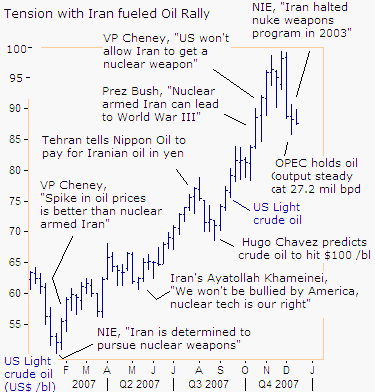
The NIE now says that the mullahs of Iran abandoned their nuclear weapons program in 2003, and thereby, effectively lifted the American military axe from over Iran's nuclear and economic infrastructure. The NIE also opened the door for foreign oil companies to develop Iran's oil fields. On Dec 9th, Iran signed a $2 billion contract with China's Sinopec 0386.hk to develop part of the Yadavaran oil field, with 3.2 billion barrels of recoverable oil reserves, and 2.7 trillion cubic feet of natural gas.
The debate surrounding the latest NIE's conclusions has already begun, and Congress wants hearings to determine if the authors are politicizing or interpreting the intelligence correctly. This is, after all, is the same group of spies that said two years ago they were certain the Iranians were developing nukes, that four years ago assured Bush that Saddam Hussein possessed weapons of mass destruction, and utterly failed to predict the Sept 11 attacks.
Now the US spy agencies have done another 180-degree turn on Iran. Earlier this year, on January 11, 2007, the US Director of National Intelligence wrote, “We assess that Teheran is determined to develop nuclear weapons, and is continuing to pursue uranium enrichment and has shown more interest in protracting negotiations than reaching an acceptable diplomatic solution.”
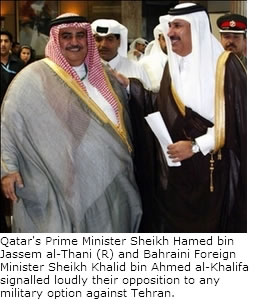 However, the latest NIE report might have been arranged with the White House, to allow Bush to hand over the Iran nuclear file to the next president rather than attempt to resolve it himself. The latest twist in Iran's cat-and-mouse nuclear game, allowed Ahmadinejad to declare victory, and it's already shifting the political order in the Persian Gulf. At a Dec 8th regional security conference, Bahraini Foreign Minister Sheikh Khaled bin Ahmed al-Khalifa welcomed Ahmadenijad's proposal to step up cooperation with Gulf Arab countries and stressed Tehran's right to develop its nuclear program. “We see Iran's proposals as positive to enhance peace in the region and to ensure stability and security,” Khalifa said.
However, the latest NIE report might have been arranged with the White House, to allow Bush to hand over the Iran nuclear file to the next president rather than attempt to resolve it himself. The latest twist in Iran's cat-and-mouse nuclear game, allowed Ahmadinejad to declare victory, and it's already shifting the political order in the Persian Gulf. At a Dec 8th regional security conference, Bahraini Foreign Minister Sheikh Khaled bin Ahmed al-Khalifa welcomed Ahmadenijad's proposal to step up cooperation with Gulf Arab countries and stressed Tehran's right to develop its nuclear program. “We see Iran's proposals as positive to enhance peace in the region and to ensure stability and security,” Khalifa said.
On Dec 3, Iran's Ahmadinejad was invited to attend a meeting of the Gulf Cooperation Council, seen by political observers as the GCC's acknowledgment of Tehran's growing regional clout. The GCC was established shortly after the outbreak of Iraq-Iran war in 1980 to strengthen Arab sheikdoms and emirates in the Gulf, and to counter Iranian influence across the region. Ahmadinejad called for the GGC to form a regional security pact with Iran and free of “foreign influence” - the US military, with about 40,000 American troops on bases across the Gulf, including Kuwait as a key staging ground for Iraq and an expanding presence in Bahrain as host of the US 5th Fleet headquarters.
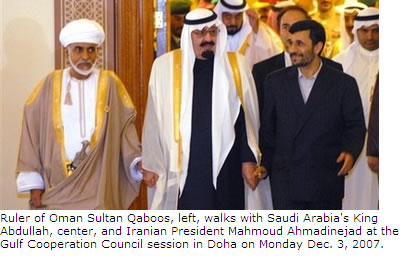 Ahmadinejad was escorted along a red carpet by King Abdullah of Saudi Arabia, and proposed the “establishment of economical and security pacts and institutions among the seven states to serve the people of our region, and enable peace and prosperity for all.” The Gulf meeting came less than a week after Arab nations attended a Bush sponsored Mideast peace summit in Annapolis, Md, which was designed to unite Arab countries against Iran, but was torpedoed by Ahamdinejad a week later.
Ahmadinejad was escorted along a red carpet by King Abdullah of Saudi Arabia, and proposed the “establishment of economical and security pacts and institutions among the seven states to serve the people of our region, and enable peace and prosperity for all.” The Gulf meeting came less than a week after Arab nations attended a Bush sponsored Mideast peace summit in Annapolis, Md, which was designed to unite Arab countries against Iran, but was torpedoed by Ahamdinejad a week later.
Ahmadinejad is especially keen to bolster relations with the United Arab Emirates, which is the leading offshore commercial center for Iran, where $300 billion of Iranian assets are held, and 10,000 Iranian companies have offices in the UAE. Trade between the two countries was over $11 billion last year.
Ahmadinejad scored another big victory on Dec 5th, when the Saudi royal family joined the hawks of OPEC – Iran, Libya, and Venezuela, and agreed to hold the cartel's oil output steady at 27.25 million bpd, to prevent a further slide in oil prices, once global demand abates after the winter. “Our position is that demand and supply are balanced and there is no need to increase oil to the market,” said Iranian Oil Minister Gholamhossein Nozari.
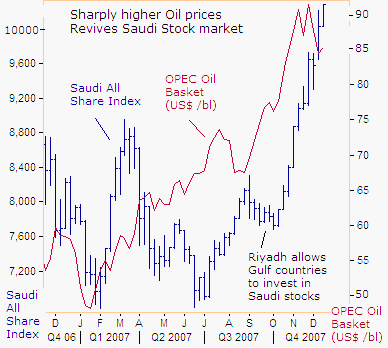
Riyadh is also keen to keep oil prices elevated within a higher target zone, to sustain the enormous flow of petro-dollars to the Gulf, which has revived the speculative appetite for the local stock markets. Yesterday, the Saudi All Share Index broke through the psychological 10,000 barrier for the first time in a year, enriching the brokerage accounts of 7,000 Saudi princes, who control 70% of the market.
Saudi king Abdullah rejected a request from the Bush administration, to boost the kingdom's oil output by 500,000 bpd, to knock oil prices sharply lower, and now must decide whether to devalue the US dollar against the Saudi riyal, for the first time in 21-years. Pressure on the Saudi Arabian Monetary Authority (SAMA) is mounting, after Saudi inflation hit 5.35% in October, it's highest since 1995, and far above the 12-month inflation average of about 3 percent.
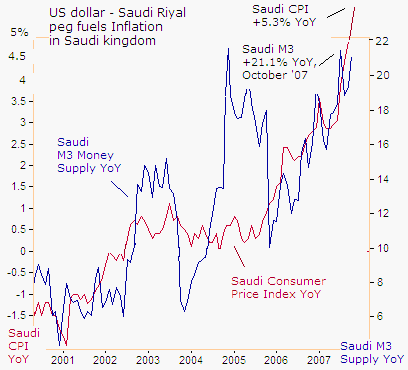
The SAMA is expanding its M3 money supply at a 21% annualized rate, in order to stay ahead of the Bernanke Fed's money printing operations. Since Bernanke got his hands on the US dollar printing press, the growth rate of the US M3 money supply has doubled to a 16% annualized rate, forcing the Gulf kingdoms to crank up their money supply, to maintain their archaic currency pegs to the dollar.
The net result is the highest inflation in decades in the Gulf kingdoms. Saudi inflation accelerated for a sixth month running, with rents jumping 11.7% in October, and food and beverage costs rising 7.5 percent. Inflation was 13.7% in Qatar at the end of September, the second-highest level on record, while in the United Arab Emirates it hit a 19-year high of 9.3 percent.
At a summit of Gulf Arab rulers last week, Saudi Arabian Finance Minister Ibrahim al-Assaf ruled out scrapping the riyal's peg to the dollar, and the SAMA cut its repo rate, used by banks to set deposit rates, by 75 basis points to 4.25%, in line with recent rate cuts by the Bernanke Fed. Thus, the SAMA is fueling faster inflation, by cutting interest rates to match the Bernanke Fed, at a time of explosive money supply growth. Meanwhile, the Euro continues to climb against the riyal, increasing the costs of European imports into the kingdom.
The Iranian “War Premium” Evaporates
Millions of words have already been written in the media about the bombshell NIE report, which destroyed a four-year diplomatic effort by Bush to isolate Iran. “There is no doubt that following this report, Iran will feel more at ease,” said Habib Fayyad, a Beirut-based political analyst and expert on Iran. “First, it will drive Moscow and Beijing to disregard calls for sanctions against Iran. There will be more division within the EU regarding Iran's nuclear program,” he said.
The Turkish newspaper Sabah wrote on Dec 8th, “After the announcement of this report, it has become more difficult for Bush or Israel to initiate a military operation against Iran. In fact, it has become impossible. Looking at it from this angle, it might even be claimed that this report, which was prepared by the intelligence institutions, aimed to prevent Bush and especially Vice-President Cheney - the king of the hawks - from dragging the country into a new adventure.”
But Jordan's Al-Dustur newspaper cautioned, “The report will certainly have a negative effect on Bush's efforts to mobilize US public opinion to support a decision for war against Iran. But this does not mean that war has become a marginalized possibility. As long as Bush is in the White House, it will be difficult to disregard the possibility of war, regardless of its form, content and duration. This also does not mean that a Democrat president will be lenient in handling the issue."
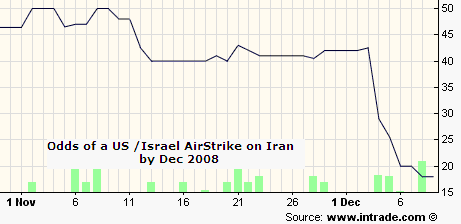
Just 18% of American voters believe the NIE claim that Iran has halted its nuclear weapons program. The latest Rasmussen Reports national telephone survey found that 66% disagree and say Iran has not stopped its nuclear weapons program. Forty-seven percent (47%) believe it is very likely that Iran will develop nuclear weapons in the future and another 34% believe Iran is somewhat likely to do so.
But the odds of a US / Israeli strike on Iran before December 2008, according to online futures markets, have plummeted from 50% in November to 18% today. The other casinos where bets on war in the Middle East are made each day are the crude oil markets in London and New York. “The market is increasingly driven by forces beyond OPEC's control, by geopolitical events and the growing influence of financial investors,” said Mohammed bin Dhaen al-Hamli who is the UAE oil minister.
The slide in crude oil from its record highs of $99.25 /barrel began on Nov 26th, soon after Saudi oil chief Ali al-Naimi remarked, “We observe with great concern the recent escalation of oil prices. But we believe that the world market is well supplied and petroleum inventories are comfortable. There's no relationship between fundamentals and the price today, there is a mismatch. Anyone who tells you otherwise is wrong,” Naimi warned.

That triggered speculation that Riyadh would pump an extra by 500,000 bpd or 750,000 bpd this winter, to drive oil prices lower, as a gift to its military patron in Washington, and crude oil quickly fell below $90 /barrel. On Nov 21st, former Saudi oil minister Ahmed Zaki Yamani engaged in psychological warfare with oil traders, predicting that oil could tumble as low as $75 a barrel if OPEC decided to raise output and if the winter season is mild. He also warned that prices could surge to $200 if the United States attacked Iran.
But Riyadh sided with the hawks, and ruled out an increase in oil output on Dec 5th, yet West Texas Sweet still found a ceiling at $90.50 /barrel. By deflating expectations of a US strike on Iran in 2008, the US spy agencies bought some time, and evaporated the Iranian “war premium” of $12 per barrel from the crude oil market. In turn, the slide in crude oil to below $90 per barrel, helped to fuel a 1,000-point rally for the Dow Jones Industrials, to the delight of the US Treasury's “Plunge Protection Team,” which is always intervening to support the stock market.
It's back to the fundamentals for Crude Oil
The 10% drop in crude oil opens the door ajar for Mr Bernanke to lower the federal funds rate by increasing the US money supply. The Bank of Canada and the Bank of England also took advantage of the CIA operation last week, lowering their lending rates by a quarter-point, to cap their currencies against the US dollar. The Canadian central bank lowered its overnight loan rate, even while its M3 money supply is expanding at a 12% annual rate, its fastest in eighteen years.
Rate cuts by the Bank of Canada and the Bank of England, and threats by Bank of Japan chief Toshihiko Fukui on Nov 26th to buy the US dollar below 109-yen, sparked a modest round of short covering in the US$ Index, which in turn, contributed to modest unwinding of long positions in crude oil. The rebound of the US dollar Index from a 20-year low of 74.85 set on Nov 26th was also guided by an up-tick in US two-year T-Note yields, from a low of 2.88% to as high as 3.16% today.
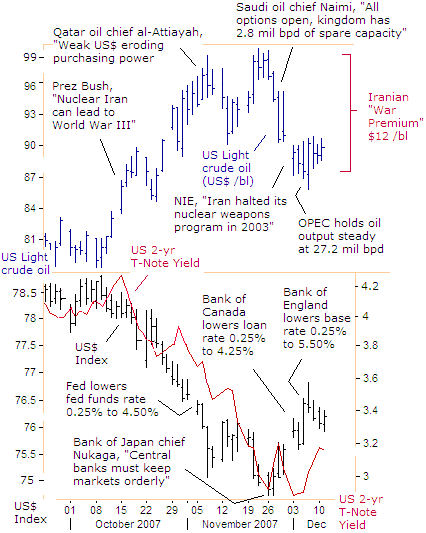
According to the US 2-year T-note market, the Bernanke Fed is expected to lower the federal funds rate to as low as 3.50% in the months ahead, which in turn, could lead to a weaker US dollar. If correct, renewed weakness in the dollar could send the price of crude oil soaring again towards $100 per barrel, unraveling the clandestine efforts of the CIA to evaporate the Iranian “war premium.”
Furthermore, the US Energy Information Agency said on Dec 11th that global oil demand in Q'1 of 2008 would climb to 87.4 million bpd, up 2% from a year earlier, and exceeding global supply, forcing oil consuming countries to dip into their emergency oil inventories. “OECD nations will have just 49.3 days of forward crude oil supply cover by February 2008, the lowest inventory buffer since December 2004, as demand growth outpaces supply” the EIA warned.
To make matters worse, a recent report by CIBC World Markets said “soaring internal rates of oil consumption” in Russia, in Mexico and in member states of the OPEC would reduce their crude oil exports as much as 2.5 million barrels a day by the end of 2010. That is about 3% of global oil demand.
“Oil prices will hit $100 a barrel before dipping to $80,” Texas oilman and hedge fund trader T. Boone Pickens predicted on Dec 11th. “Get ready for $100, it is coming up. A hundred dollars will come before $80. You'll see $100 oil within the next six months. A hundred dollars is going to become routine,” he declared.
Beijing vows to Tighten Liquidity, curb Inflation,
Much of the demand side of the equation for crude oil centers on the growth rate of the Chinese economy, which is steaming ahead at an 11.5% annualized rate, its fastest in a decade. Likewise, Chinese oil imports from January thru November were up 12.5% from a year earlier at 150.3 million tons. The strong imports were partly due to state refiner Sinopec SNP.N, which pumped oil into government storage tanks in east China, mostly in the first half of the year.
But last week, the Xinhua News agency said a decision was made behind closed-doors by China's Communist kingpins, to shift the central bank's “monetary policy from prudent to tight” in 2008, in order to slow down the economy and stamp out inflation. Consumer prices were 6.9% higher in November, an 11-year high, threatening social unrest. House prices in 70 major cities jumped 9.5% in October from a year earlier, and Beijing raised retail fuel prices by 10% last month.
The Chinese central bank ordered local banks to increase their cash reserves by 1% to 14.5% of deposits, the highest since 1987. The latest move will drain about 380 billion yuan ($51 billion) out of the banking system, “aimed at strengthening liquidity management in the banking system and checking excessive credit growth,” the PBoC explained. It was the tenth hike in reserve requirements this year.
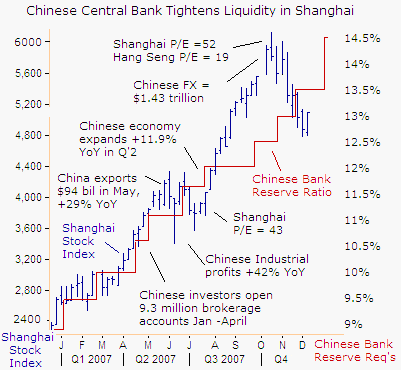
Central banks can inflate stock market bubbles and they can engineer downside corrections, with the flip of a switch. The mighty Shanghai red-chip market, which soared over 500% for the past two years, suffered a 20% correction since early October, as the PBoC became more aggressive in draining liquidity to defuse the stock market bubble, where P/E's had reached 53, the world's highest.
If the crosscurrents between Chinese and US monetary policies continue into next year, then traders are likely to witness the US money supply expanding at a faster rate than the supply of Chinese yuan for the first time in history. That's expected to put downward pressure on the US dollar against the yuan, which is necessary to reduce China's mushrooming trade surpluses, expected to hits $268 billion this year.
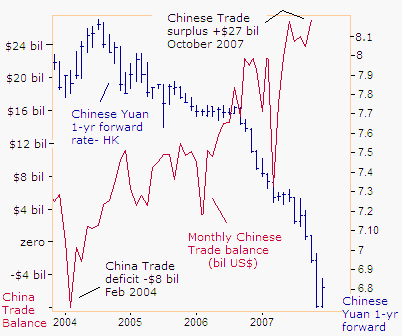
US Treasury chief Henry Paulson wants a stronger yuan to slow the expansion of China's trade surplus and avoid protectionism abroad. “A more flexible currency is especially important now, when the risks of inflation are clearly rising,” Paulson said last week. A stronger yuan would lower the price of key imported commodities such as iron ore, crude oil and grains, which is fueling local inflation.
In Hong Kong, traders in the forward currency market expect the US dollar to tumble to 6.8 yuan within a year, from around 7.39 yuan today, or a 8% devaluation, and a faster rate of decline than over the past few years. The dollar has lost 12% against the yuan since Beijing abandoned its peg in July 2005. At some point in the future, the Arab oil kingdoms are expected to follow the lead of the Chinese central bank, by reining in their money supply and devaluing the US dollar.
By Gary Dorsch,
Editor, Global Money Trends newsletter
http://www.sirchartsalot.com
To stay on top of volatile markets, subscribe to the Global Money Trends newsletter today, which includes a special bonus for new subscribers, - “Audio Broadcasts”, posted on Monday and Wednesday evenings, during Asian trading hours, to the Log-In section of our website. This article was just the Tip of the Iceberg , of what's inside the Global Money Trends newsletter, published on Friday afternoon. Here's what you will receive with a subscription,
Insightful analysis and predictions of the (1) top dozen stock markets around the world, Exchange Traded Funds, and US home-builder indexes (2) Commodities such as crude oil, copper, gold, silver, the DJ Commodity Index, and gold mining and oil company indexes (3) Foreign currencies such as, the Australian dollar, British pound, Euro, Japanese yen, and Canadian dollar (4) Libor interest rates, global bond markets and central bank monetary policies, (5) Central banker "Jawboning" and Intervention techniques that move markets.
GMT filters important news and information into (1) bullet-point, easy to understand analysis, (2) featuring "Inter-Market Technical Analysis" that visually displays the dynamic inter-relationships between foreign currencies, commodities, interest rates and the stock markets from a dozen key countries around the world. Also included are (3) charts of key economic statistics of foreign countries that move markets.
To order a subscription to Global Money Trends , click on the hyperlink below,
http://www.sirchartsalot.com/newsletters.php
Mr Dorsch worked on the trading floor of the Chicago Mercantile Exchange for nine years as the chief Financial Futures Analyst for three clearing firms, Oppenheimer Rouse Futures Inc, GH Miller and Company, and a commodity fund at the LNS Financial Group.
As a transactional broker for Charles Schwab's Global Investment Services department, Mr Dorsch handled thousands of customer trades in 45 stock exchanges around the world, including Australia, Canada, Japan, Hong Kong, the Euro zone, London, Toronto, South Africa, Mexico, and New Zealand, and Canadian oil trusts, ADR's and Exchange Traded Funds.
He wrote a weekly newsletter from 2000 thru September 2005 called, "Foreign Currency Trends" for Charles Schwab's Global Investment department, featuring inter-market technical analysis, to understand the dynamic inter-relationships between the foreign exchange, global bond and stock markets, and key industrial commodities.
Copyright © 2005-2007 SirChartsAlot, Inc. All rights reserved.
Disclaimer: SirChartsAlot.com's analysis and insights are based upon data gathered by it from various sources believed to be reliable, complete and accurate. However, no guarantee is made by SirChartsAlot.com as to the reliability, completeness and accuracy of the data so analyzed. SirChartsAlot.com is in the business of gathering information, analyzing it and disseminating the analysis for informational and educational purposes only. SirChartsAlot.com attempts to analyze trends, not make recommendations. All statements and expressions are the opinion of SirChartsAlot.com and are not meant to be investment advice or solicitation or recommendation to establish market positions. Our opinions are subject to change without notice. SirChartsAlot.com strongly advises readers to conduct thorough research relevant to decisions and verify facts from various independent sources.
Gary Dorsch Archive |
© 2005-2022 http://www.MarketOracle.co.uk - The Market Oracle is a FREE Daily Financial Markets Analysis & Forecasting online publication.


